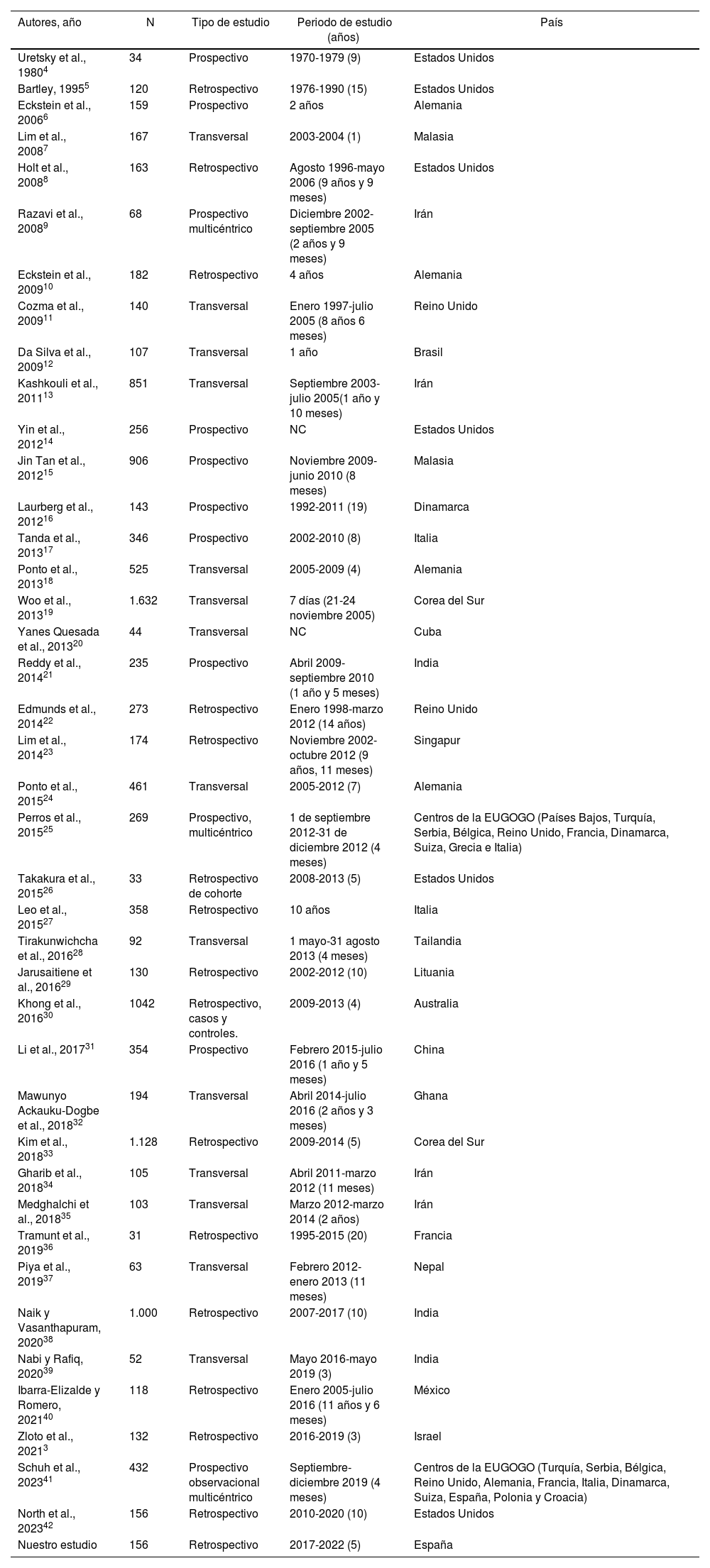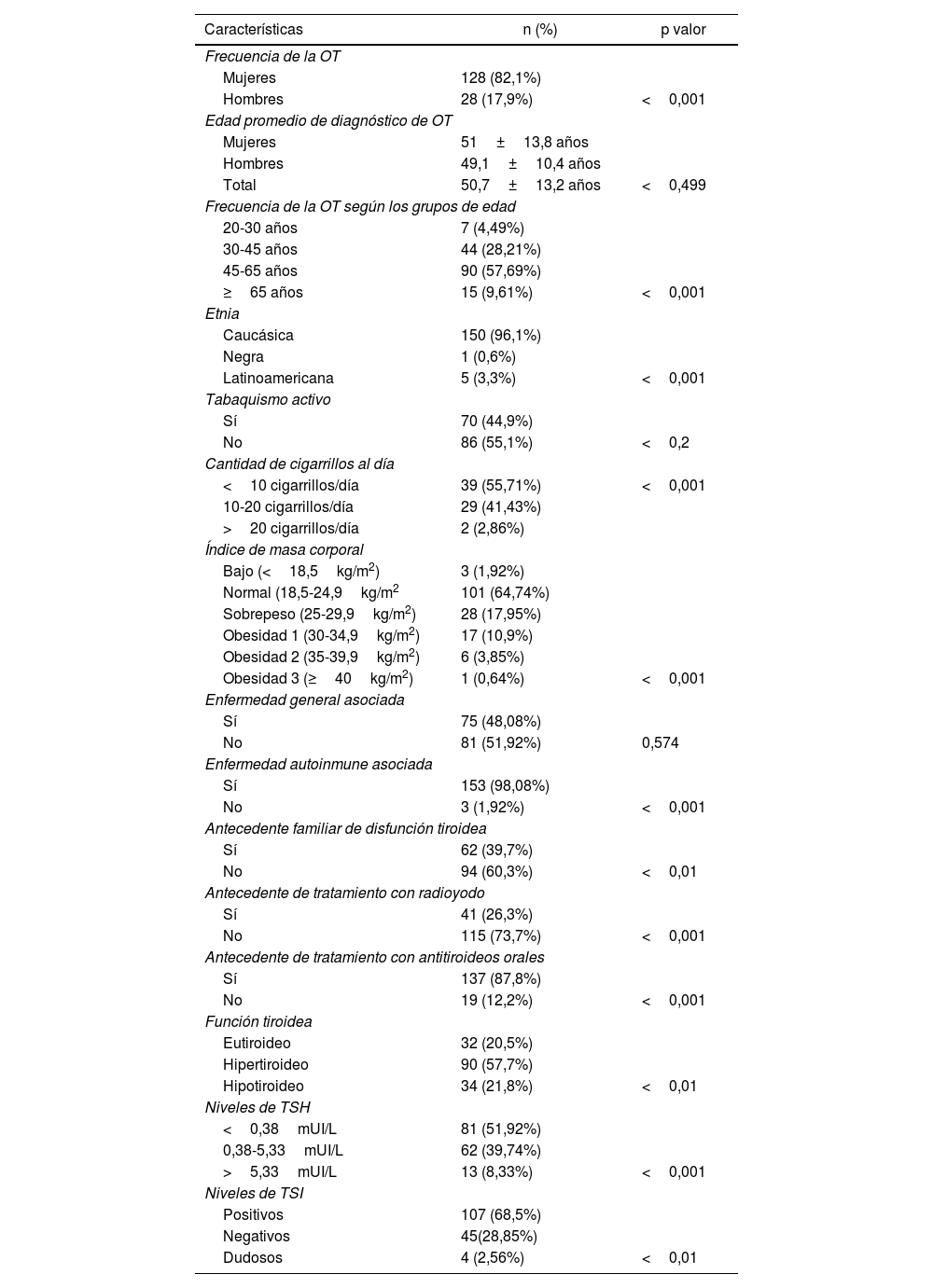Describir las características demográficas y clínicas de la orbitopatía tiroidea (OT) de una población en España.
MétodoEs un estudio observacional retrospectivo de pacientes con OT atendidos en un centro hospitalario de tercer nivel. Se recogieron datos demográficos, clínica oftalmológica, lateralidad, simetría, recidivas, actividad según la escala de Clinical Activity Score, la gravedad según European Group On Graves’ Orbitopathy (EUGOGO), función tiroidea y niveles de anticuerpos. Se definió una significación estadística para valores p<0,05.
ResultadosSe incluyeron 156 pacientes con OT; 128 (82,1%) mujeres; la ratio de sexo femenino/masculino fue de 4,57:1. La incidencia acumulada fue de 7,47 casos por cada 100.000 habitantes/año. La edad media fue de 50,7±13,2 años; 62 (39,7%) pacientes tuvieron antecedente familiar de disfunción tiroidea; 70 (44,9%) pacientes eran fumadores. Se presentó hipertiroidismo en 90 (57,7%) pacientes, hipotiroidismo en 34 (21,8%) y eutiroidismo en 32 (20,5%). La inmunoglobulina estimulante del tiroides se presentó elevada en 107 (68,5%) pacientes. La OT fue bilateral en 149 (95,51%) y simétrica en 99 (66%). Se presentó OT activa en 28 (17,9%) pacientes; 110 (70,5%) OT fueron leves, 41 (26,3%) moderadas-severas y 5 (3,2%) muy severas. La OT moderada-severa fue mayor en fumadores comparado con no fumadores (32,9% vs. 20,9%, p=0,524).
ConclusionesLa OT en nuestra población sigue patrones parecidos a otros países: sexo femenino, leve, bilateral y simétrica. En fumadores la OT puede presentarse con más gravedad.
To describe the demographic and clinical characteristics of thyroid orbitopathy (TO) in a population in Spain.
MethodIt is a retrospective observational study of patients with TO treated at a tertiary hospital center. We gathered demographic data, ophthalmological symptoms, laterality, symmetry, recurrences, activity according to the Clinical Activity Score scale, severity according to the European Group On Graves’ Orbitopathy (EUGOGO), thyroid function and antibody levels. Statistical significance was defined for p values <0.05.
ResultsOne hundred fifty-six patients with TO were included. One hundred twenty eight (82.1%) women, the female/male sex ratio was 4.57:1. The cumulative incidence was 7.47 cases per 100,000 inhabitants/year. The mean age was 50.7±13.2 years. Seventy (44.9%) patients were smokers. Sixty two (39.7%) patients had a family history of thyroid dysfunction. Hyperthyroidism occurred in 90 (57.7%) patients, hypothyroidism in 34 (21.8%) patients, and euthyroidism in 32 (20.5%) patients. Thyroid-stimulating immunoglobulin was elevated in 107 (68.5%) patients. The TO was bilateral in 149 (95.51%) and symmetrical in 99 (66%). Active TO occurred in 28 (17.9%) patients. One hundred ten (70.5%) TO were mild, 41 (26.3%) moderate-severe and 5 (3.2%) very severe. Moderate-severe TO was higher in smokers compared to non-smokers (32.9% vs. 20.9%, p=0.524).
ConclusionsTO in our population follows similar patterns to other countries: female sex, mild, bilateral and symmetrical. In smokers, TO may present more severely.
Artículo
Comprando el artículo el PDF del mismo podrá ser descargado
Precio 19,34 €
Comprar ahora











